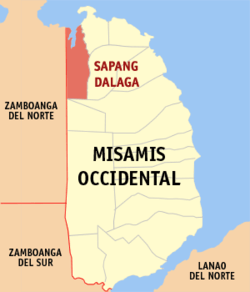Sapang Dalaga, Misamis Occidental
Sapang Dalaga, officially the Municipality of Sapang Dalaga (Cebuano: Lungsod sa Sapang Dalaga; Tagalog: Bayan ng Sapang Dalaga), is a 5th class municipality in the province of Misamis Occidental, Philippines. According to the 2015 census, it has a population of 19,983 people.[3]
Sapang Dalaga | |
|---|---|
| Municipality of Sapang Dalaga | |
| Etymology: Maiden in a creek | |
 Map of Misamis Occidental with Sapang Dalaga highlighted | |
OpenStreetMap 
| |
.svg.png) Sapang Dalaga Location within the Philippines | |
| Coordinates: 8°33′N 123°34′E | |
| Country | |
| Region | Northern Mindanao (Region X) |
| Province | Misamis Occidental |
| District | 1st District |
| Founded | August 12, 1957 |
| Barangays | 28 (see Barangays) |
| Government | |
| • Type | Sangguniang Bayan |
| • Mayor | Donjie D. Animas |
| • Vice Mayor | Emilou M. Animas |
| • Congressman | Diego C. Ty |
| • Electorate | 14,199 voters (2019) |
| Area | |
| • Total | 93.93 km2 (36.27 sq mi) |
| Population (2015 census)[3] | |
| • Total | 19,983 |
| • Density | 210/km2 (550/sq mi) |
| • Households | 4,545 |
| Economy | |
| • Income class | 5th municipal income class |
| • Poverty incidence | 41.41% (2015)[4] |
| • Revenue (₱) | 65,438,766.85 (2016) |
| Time zone | UTC+8 (PST) |
| ZIP code | 7212 |
| PSGC | |
| IDD : area code | +63 (0)88 |
| Climate type | tropical climate |
| Native languages | Subanon language Cebuano Tagalog |
| Website | www |
It is located 96 kilometres (60 mi) from Ozamiz City and 50 kilometres (31 mi) from Dipolog City airport.
It is rich in mineral resources such as gold, copper and manganese, and has mountains, rivers, waterfalls and beaches. Baga (waterfalls in the native language) with its scenic beauty is a kilometer from the town center, can be reached by foot or motor vehicles. Panoramic mountains such as Mount Dasa and Mount Pedoluan reside. Casul Bay which connects to Murcielagos Bay can be navigated.
Etymology
Its name is derived from the phrase sapa ng dalaga (ancient Visayan language dating back to the 14th century before Spanish colonization), meaning "maiden in a creek".
The names of some barangays were derived from rivers and trees, for example, Guinabot came from a river, Locus was derived from the native locus tree.
Barangays
Sapang Dalaga is politically subdivided into 28 barangays.
- Bautista
- Bitibut
- Boundary
- Caluya
- Capundag
- Casul
- Dalumpinas
- Dasa
- Dioyo
- Disoy
- El Paraiso
- Guinabot
- Libertad
- Locus
- Macabibo
- Manla
- Masubong
- Medallo
- Agapito Yap Sr. (Napilan)
- Poblacion
- Salimpuno
- San Agustin
- Sapang Ama
- Sinaad
- Sipac
- Sixto Velez Sr.
- Upper Bautista
- Ventura
Climate
| Climate data for Panaon, Misamis Occidental | |||||||||||||
|---|---|---|---|---|---|---|---|---|---|---|---|---|---|
| Month | Jan | Feb | Mar | Apr | May | Jun | Jul | Aug | Sep | Oct | Nov | Dec | Year |
| Average high °C (°F) | 27 (81) |
27 (81) |
29 (84) |
30 (86) |
30 (86) |
29 (84) |
29 (84) |
29 (84) |
30 (86) |
29 (84) |
29 (84) |
28 (82) |
29 (84) |
| Average low °C (°F) | 22 (72) |
22 (72) |
22 (72) |
23 (73) |
24 (75) |
24 (75) |
23 (73) |
23 (73) |
23 (73) |
23 (73) |
23 (73) |
22 (72) |
23 (73) |
| Average precipitation mm (inches) | 69 (2.7) |
44 (1.7) |
37 (1.5) |
29 (1.1) |
87 (3.4) |
137 (5.4) |
131 (5.2) |
141 (5.6) |
143 (5.6) |
134 (5.3) |
68 (2.7) |
53 (2.1) |
1,073 (42.3) |
| Average rainy days | 9.9 | 7.6 | 7.4 | 8.1 | 21.6 | 26.5 | 26.4 | 26.6 | 25.8 | 24.3 | 15.1 | 10.4 | 209.7 |
| Source: Meteoblue [5] | |||||||||||||
Demographics
|
| ||||||||||||||||||||||||||||||||||||
| Source: Philippine Statistics Authority[3][6][7][8] | |||||||||||||||||||||||||||||||||||||
In the 2015 census, the population of Sapang Dalaga was 19,983 people,[3] with a density of 210 inhabitants per square kilometre or 540 inhabitants per square mile.
Economy
Its economy is based on agriculture, with root crops such as gabi, palaw, sweet potato, ube and apale. It has plantation of coconuts, lanzones, mangosteen, rambotan, marang, hibi (June plume), guyabano, santol, durian and native bananas. Herbal plants such as Salingkapao (tawa-tawa), buyo, dalapot (sambong) grows in each household plot. Vegetables such as string beans, squash, malunggay, likway, bago and sikwa can be found. Sea foods such as bongcawel, saang, bacase, king crabs, nukos (squid), lato (seaweeds), kitong, dangget, lapu-lapu, pasayan (prawn) can be bought every Friday (market day).
References
- "Municipality". Quezon City, Philippines: Department of the Interior and Local Government. Retrieved 31 May 2013.
- "Province: Misamis Occidental". PSGC Interactive. Quezon City, Philippines: Philippine Statistics Authority. Retrieved 12 November 2016.
- Census of Population (2015). "Region X (Northern Mindanao)". Total Population by Province, City, Municipality and Barangay. PSA. Retrieved 20 June 2016.
- "PSA releases the 2015 Municipal and City Level Poverty Estimates". Quezon City, Philippines. Retrieved 12 October 2019.
- "Sapang Dalaga: Average Temperatures and Rainfall". Meteoblue. Retrieved 29 April 2020.
- Census of Population and Housing (2010). "Region X (Northern Mindanao)". Total Population by Province, City, Municipality and Barangay. NSO. Retrieved 29 June 2016.
- Censuses of Population (1903–2007). "Region X (Northern Mindanao)". Table 1. Population Enumerated in Various Censuses by Province/Highly Urbanized City: 1903 to 2007. NSO.
- "Province of Misamis Occidental". Municipality Population Data. Local Water Utilities Administration Research Division. Retrieved 17 December 2016.